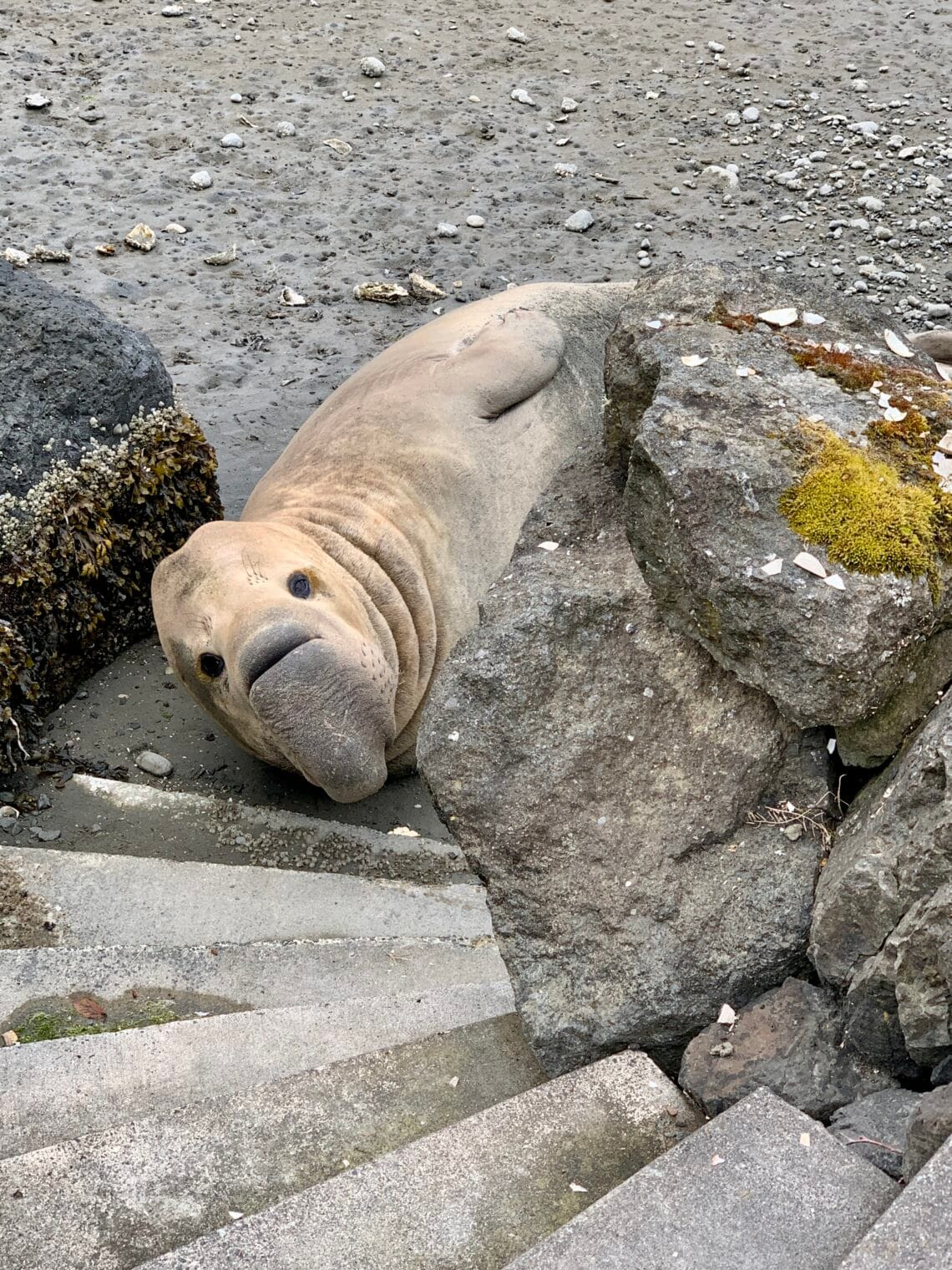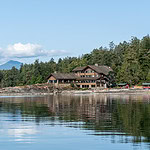This, my friends, is an elephant seal. I noticed him lying in the mud at the base of our breakwater stairs when I returned from the dock this morning.

Under most conditions, the water would lap up against the rocks, but we are in a period of unusually low tides.
Is he stranded? Injured? Resting? I figured that if I got closer and he felt OK, he would probably try to move away. But instead, I got this pathetic look and a lot of heavy sighs.

I found the appropriate reporting phone number and told them about my unexpected visitor. They told me he’s been sighted at various places on Bainbridge Island and in the Poulsbo area. They suspect that he’s looking for a place to molt. Allens Cove seems like a less-than-ideal spot to me, but what do I know? I hope he doesn’t stick around because, from what I’ve read, the molting process is pretty gross.
Right now, I’m on Poo Watch. If he performs, they’ll send someone out to collect a sample in order to determine whether he’s sick. I guess I’m off duty once the rising tide reaches his bum. How are you spending this holiday weekend?

Elephant Seal Facts
Location: Can be found from coastal Baja California to the Gulf of Alaska. Adult Northern Elephant Seals arrive in California and Mexico between December and March to give birth and mate. After pupping and mating, the adults and young migrate to their feeding grounds as far north as the Aleutian Islands. They have one of the longest migrations of any mammal. Some have been recorded traveling over 13,000 miles roundtrip.
Lifespan: 13-19 years, with females living longer than males.
Size: Males range from 12-16 feet and weigh up to 5,000 pounds (2,268 kg). Females are smaller, range from 7-12 feet, and weigh around 2,000 pounds (907 kg). Weaners range from 220-352 pounds (100-160 kg).
Diet: Squid, octopus, small sharks, rays, and large fish. They can dive for 80 minutes and reach depths of 5,000 feet.
Reproduction: Males form harems usually when they are 9-10 years of age, battling for status in the social hierarchy. Females come ashore and, within a few days, give birth to a pup conceived in the previous breeding season. A few days before her pup is weaned, she breeds again and then returns to sea. They fast during mating season and can lose up to 36% of their body weight during this time.
Gestation: 11 months
Lactation: No more than one month.
Behavior: These animals are polygynous breeders with a social hierarchy. When molting occurs, they shed their short, dense pelage along with large patches of old skin. Molting is a natural condition that takes 4-5 weeks to complete and is not an attractive process; this does not mean they are injured. Juveniles sometimes get “scabby molt” with skin lesions, and birds will pick, making the process even more gruesome. Elephant seals are vulnerable during molting and some animals will die. Hauling out on shoreline habitat allows the skin to warm up and will help the molting process, do not attempt to feed our pour water on the animal. The best thing you can do is stay 100 yards away from the animal!
Identification: When males reach puberty at about 7 years old, they develop a large inflatable nose, or “proboscis.” They also develop a robust, thick neck that is heavily creased and lighter in color. Females maintain their smaller noses and smooth necks.
Threats: Entanglement in marine debris, fishery interactions, and boat collisions.






Joe
May 27, 2024 — 7:59 am
Fascinating!
Meelie Dong
May 27, 2024 — 8:29 am
Molting does indeed sound gross. So does being a female elephant seal. 11 month gestation period Pup. One month lactation. Join a harem and brews before going out to sea for 11 months. No fair, Mother Nature!
Barb
May 27, 2024 — 9:31 am
Sorry about the poo watch but he does/did look sad. I had to be on bat watch last year when one was found in an unlikely place – unfortunately he didn’t make it 🙁
Alison Shaw
May 29, 2024 — 6:40 am
I wondered if you should be throwing water on it. Thanks for the details, which answered my question.
And, yes, he looks so sad, even though I know this is probably anthropomorphism on my part.
Michael Barnes
May 29, 2024 — 9:13 pm
Thank you for this in-depth, information-wise-report.
Always pleased to see an Elephant Seal, or even an Elephant would be nice
(if not molting!) I will certainly come to visit you, myself, when I molt!
Hello to the both of you! Such a eventful life you lead!! Love, MEB
Steve P
May 29, 2024 — 9:20 pm
If you’re molting, you will be sleeping on the tide flats.